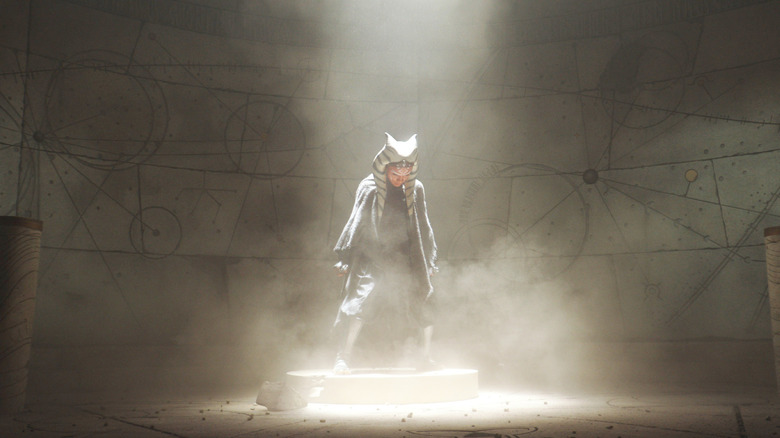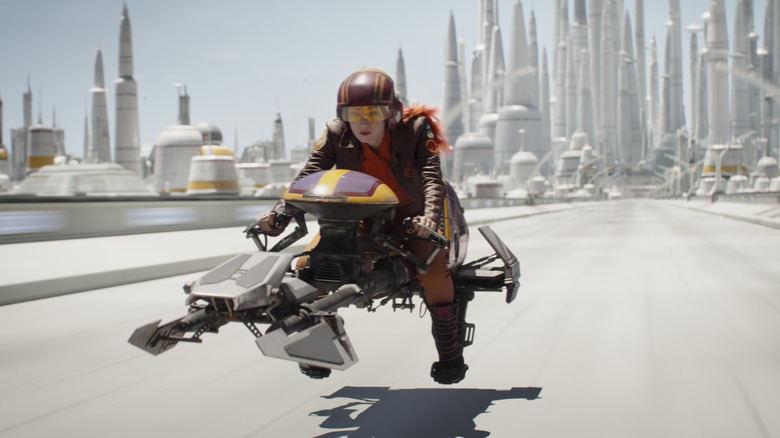Ahsoka Fixes One Major Mandalorian Mishap
This article contains spoilers for "Ahsoka."
After only two episodes of "Ahsoka," the hotly anticipated series already feels much more massive in scope than the other "Star Wars" television shows that have come before. That may be because of the looming backstory accompanying this particular plotline that ties directly into the already established lore of "The Mandalorian" and four animated seasons of "Star Wars Rebels." That's a lot of loose ends and story threads to keep up and contend with. There are much bigger ideas at play here, involving more complicated, new age concepts that delve into the more mystical side of the "Star Wars" galaxy. Suddenly, there are witches, ancient Force users, and the "Star Wars" equivalent of time travel to contend with.
This all makes the established universe feel larger than ever before. It's not just the epic stakes that make "Ahsoka" seem grander, however. The level of filmmaking from writer-director Dave Filoni in episode 1, "Master and Apprentice," and director Steph Green in episode 2, "Toil and Trouble," also just feels bigger.
While still mostly delivering an acceptable level of scale, a lot of new "Star Wars" shows have faced some criticism for making the universe seem smaller than it really is. That's the nature of television production, and even with Lucasfilm's impressive budgets, sometimes the sets and the action don't sell the world enough. So far, "Ahsoka" has managed to sidestep the pitfalls that "The Mandalorian," "The Book of Boba Fett," and "Obi-Wan Kenobi" have fallen into to deliver the most dizzying spectacle yet for any "Star Wars" show during the Disney+ streaming era.
Ahsoka avoids a problem from other Star Wars shows: space
Aside from "Andor," which was mostly shot on location, all of the live-action "Star Wars" shows have been filmed using StageCraft technology (commonly referred to as The Volume) featuring wrap-around video walls to sell the effect of being outdoors. While still in its infancy, the game engine tech definitely had its limitations, but "Ahsoka" has mostly mastered the art of deception to create a fully-realized, utterly convincing world.
From the start, "Master and Apprentice" makes it a point to showcase the vastness of the "Star Wars" galaxy. When Ahsoka flees the self-destruct blast set off by assassin droids, the relatively small ruins at the Arcana temple give way to miles of real estate for her to navigate in order to outrun the flames. Sabine Wren's introduction on Lothal also immediately achieves a great sense of space as she outmaneuvers a pair of X-wings on her speeder bike. Similarly, in "Toil and Trouble," Ahsoka and Hera's battle with Imperial loyalists through the colossal shipyards on Corelia is absolutely staggering to behold. This series is one of the crown jewels of Lucasfilm, and so far, it looks like it.
Frankly, I don't want to see the obvious limitations of The Volume that popped up multiple times on "The Mandalorian." Nor do I want to witness another snail-paced speeder chase like the one in "Boba Fett" or watch Ewan McGregor trot back-and-forth on the same stretch of set running after a precocious Leia in "Obi-Wan Kenobi." The question is whether or not "Ahsoka" can keep this level of grandeur and size going for eight full episodes. With the show's main villain, Grand Admiral Thrawn still lurking in the shadows, I'm willing to bet a few credits the show's only going to get bigger from here.
New episodes of "Ahsoka" premiere Tuesday nights at 6:00pm Pacific, 9:00pm Eastern on Disney+.

